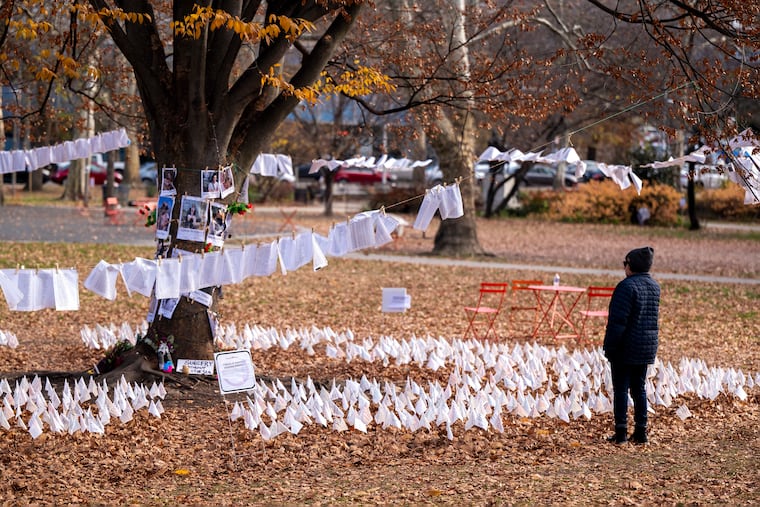City postpones removal of Palestinian memorial site in West Philly’s Clark Park after pushback
Community members said the Palestine Vigil has a space for public grieving since Oct. 28, but officials said there’s a 15-day limit on such displays.

Philadelphia officials planned to remove a memorial in Clark Park for Palestinians killed in the ongoing conflict with Israel due to a policy limiting how long these displays can remain in public parks. But the city temporarily postponed those plans on Tuesday amid pushback from residents and elected officials in West Philadelphia.
The memorial, known as the Palestine Vigil, has adorned the northwest corner of Clark Park since Oct. 28, creating what community members described as a space for public grieving around the fraught overseas conflict. Hundreds of small, white flags dot the leaf-strewn autumn ground, each one bearing the name and age of a Palestinian victim. Pictures of their faces hang from nearby trees.
In a memo posted on social media Monday, Philadelphia Parks & Recreation said the installation had well exceeded the city’s 15-day life span for memorials in public spaces — and announced plans to remove it on Tuesday.
“The City realizes that temporary memorials and displays in public spaces are often a response to a sensitive situation, and seeks to be respectful in any action taken with regard to the placement, relocation, or removal of such displays,” Orlando Rendon, interim Parks & Recreation commissioner, wrote. But he claimed the city was unable to contact the project’s backers to discuss a timeline for removal.
Supporters said that wasn’t true.
Bennett Kuhn, a resident near Clark Park for more than eight years, said notices were posted at the memorial site before the Thanksgiving holiday last week and residents who supported the project reached out to ask for a meeting with Parks & Recreation and discuss acquiring a short-term permit for the display. They didn’t get a response until this week. On Monday and Tuesday, a group showed up to guard the installation in the chilly morning hours, even amid flurries.
“There’s a tremendous love of this site in the community,” Kuhn said. “People came ...in the dawn and in the cold to be here, to make sure that this site is protected, and that a transparent process of review is had.”
A spokesperson for Mayor Jim Kenney confirmed Tuesday that the removal has been postponed until after the community meeting on Wednesday, and reiterated the city’s position about the 15-day policy. The city is “committed to the consideration of and care for every community in our region that may be experiencing pain and trauma due to the conflict in the Middle East,” the spokesperson added, referring to a city resource guide for people struggling to process the war.
Kuhn said the city’s policy is understandable for pop-up memorial sites for gun violence and car crash victims. But the nature of the conflict, he argued, was a long-term conflict and should not be held to what he described as an arbitrary window. Some of the victims honored by the memorial site date back to 2014, years before the Israel-Hamas war began. “This is an ongoing response to an ongoing violence that is occurring abroad, but also impactful here in Philadelphia,” he said.
The city declined to say whether it received complaints about the memorial site.
Friends of Clark Park, a volunteer advisory group for the Baltimore Avenue green space, noted that it does not have jurisdiction to remove installations in the park. In a statement, the group’s board said it was devastated by the ongoing conflict in the Middle East and said its mission is to “ensure that Clark Park embraces everyone and enhances the health and happiness of our neighborhood.”
Councilmember Jamie Gauthier and State Rep. Rick Krajewski both asked the city to allow the memorial to remain in place.
Gauthier, whose West Philadelphia district anchors the park, said she had seen two emails and a Facebook post criticizing the display. But those complaints paled next to the hundreds of constituents who had asked her office to protect the installation, which she said had become a popular meeting point at the park.
Gauthier characterized the city’s reasoning as a kind of “policy over people” bureaucracy. To her, the site epitomized a peaceful use of public space that the city should be encouraging.
“It’s a place for people to heal, to mourn, to reflect,” Gauthier said. “I don’t know why we would take that away from the community, or why we would put a policy over people’s well-being and feelings.”
Gauthier said she planned to attend the meeting between the city and the community members on Wednesday.